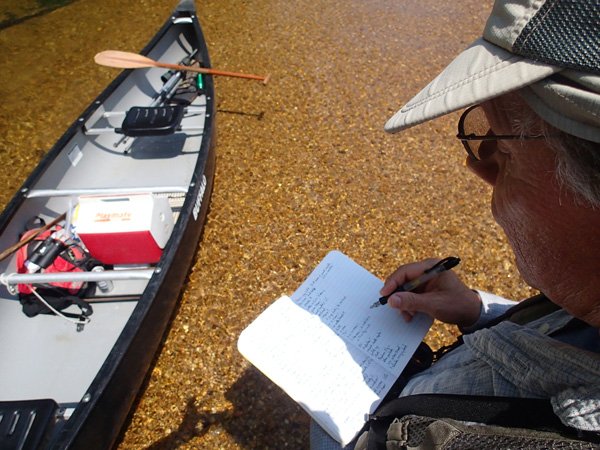Flip Putthoff invited me to go birding on the Kings River. All I had to do was spot birds and such, as we floated, with me enthroned under a gilded canopy atop his barge - actually me being the front paddler in his Buffalo canoe. Experienced helmsman Flip guided us down the Nile, oops, the Kings.
We floated about 5 miles from Kings River Outfitters to
McMullen Farm, a private take-out that outfitters lease. This is rugged country, a little south of Eureka Springs.
In just a few hours our list topped 50: five Yellow-billed cuckoos, six great crested fly-catchers, six northern rough-winged swallows, nine yellow-throated warblers, five Kentucky warblers, five belted kingfishers (with at least one carrying food, maybe crawfish, to a nest.) And at least 10 Louisiana water thrushes scattered on shady banks and walking on snags.
The Kings today was an immaculate series of smooth rifies, clean gravel bars, beds of green water-willow covered with masses of purple orchidlike blooms, and water like a well-tended aquarium. Cleopatra never had it so good. Riffles murmured spring easing into summer; indigo buntings, eastern wood-pewees, from a shady spot, an Acadian fly-catcher and bullfrogs starting up.
I got an eco-happy rush when I saw what had been done at the boat launch at Kings River Outfitters. Periodic flooding tends to damage the best places to launch. One way to fix this would be to run your tractor into the river, scoop up gravel and dump it on the bank. Instead of messing up gravel bars and the hydrology of the river, they hauled in crushed limestone.
Seeing folks go the extra mile like this set me up comfortable and easy for collecting floating-downriver bird data. Green herons on a gravel bar, summer tanager singing atop a forested bluff , white-eyed vireos (5) in the thickets of willows and young sycamores. Northern parulas (6, probably more) where river birches lean over the Kings.
We came through a shallow S-shaped riffle and floated over a broad rock shelf. There in the clear water were northern hogsuckers, 20 or 30, large and small.
Hogsuckers are super-sensitive to all of the usual man-made problems that degrade streams - deforestation that leads to sedimentation, dam building, other types of pollution.
Seeing hogsuckers, you’re seeing a wild and relatively free river.
Of course, we’d heard that already in the singing of Louisiana water thrushes.
I don’t know if they are nesting in the Kings valley,but the presence of a bald eagle along the river today suggests it. We watched as it lifted oft from a tall sycamore.
I silently thanked all of you who have supported the Endangered Species Act, rational thinking about our relationship to the planet, those sensible personal acts of kindness to nature.
Outdoor, Pages 6 on 06/27/2013

